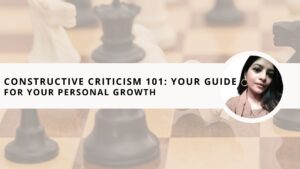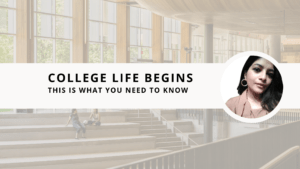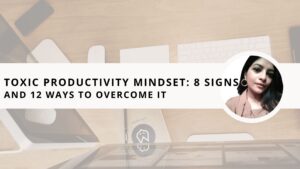Have you ever wondered why you do some tasks so efficiently and why some of them take so much time? The answer is your cognitive development. Let’s understand this concept better today!
Your cognitive skills are working every second for you.
The word cognitive skills lead me to research and I found some interesting facts which I want to share with you.
Whenever you do an activity, your cognitive skills are at work. These are the skills that help you to complete one task easily or take a little more time for other tasks.
Your cognitive development begins at an early stage in life. How, when, where, and what is everything you are going to learn today? Let’s go!
Cognitive Development 101: An Ultimate Guide to Understanding Your Skills
Before we get into learning more about cognitive development, let us first understand what cognition is.
Cognition is the process of developing knowledge and understanding in the mind. It helps in developing your thinking ability, improving your attention, and shaping your memory.
What are Cognitive skills and their types?
Cognition is the mental process by which the brain receives, stores, manipulates, and uses information. It helps in performing big complicated as well as small simple tasks. It may overlap while doing specific tasks.
For example, reading a book involves both attention and remembering skills. With cognitive skills, you can read your books and remember them.
Your cognitive skills include:
- Mobility
- Memory
- Attention
- Perception
- Processing
- Logic and reasoning
Let’s learn about each of these one by one:
1. Attention:
Attention is concentrating or focusing on a particular object or thought for a long time. The types of attention are as follows: sustained, selected, and divided.
- Sustained attention is concentrating on an object for a long time without distraction.
- In Selective attention, you get distracted when focusing on an object for a long time.
- In divided attention, you do multitasking. For example, you can remember information while talking.
2. Perception:
Your sensory organs and brain can recognize your thoughts and environment. This ability is called Perception.
For example, your tongue and brain can tell the food’s taste and its chemical composition, or
when you help others, your mind feels the perception of happiness.
3. Memory:
The two sections of your memory are short-term memory and long-term memory.
Human memory is the same as a digital computer. When you have weak long-term memory, you cannot access information. Emotions, divergent data, and relational data are things humans can easily remember. The best way to remember is by repeated actions or in a relational way.
Short-term memory processes information, external stimuli, or thoughts consciously.
You can program your long-term memory by practicing short-term skills repeatedly. This is how an action becomes a habit.
4. Logic and Reasoning
This is the skill that lets you understand the cause of an action and justify its results.
Inductive and Deductive reasoning helps your brain identify logical situations. The human brain does not adopt deductive reasoning in most cases.
You can improve the skill by just asking the questions yourself. You need logical skills for innovation, rational thinking, and problem-solving.
5. Processing
Processing speed is the speed at which your brain thinks or reflects. The human brain remembers information in the form of images and sounds.
Long-term memory stores images and sounds and helps to visualize when you recall. This is how you can remember the information as images or sounds for higher processing speed.
6. Mobility
Mobility is how your brain mobilizes your body part or muscle. It is how you learn to crawl, walk, and eventually run. Practice can help you improve mobility.
Cognitive skills are your everyday skills. You use it for decision-making and communication.
To select between two products, you use cognitive skills. They help you to read labels and analyze their ingredients. You even perform quality analysis and find the best product.
One cannot have adult cognitive skills by birth.
You are not born with cognitive skills. They develop and mature with your physical and mental growth. The child has some skills by nature because of their genes and they obtain other skills by nurture. However, nurture refers to the physical and social environment in which the child lives.
What is Cognitive Development?
The change in cognitive skills as you grow and mature is called Cognitive development. For example, language skills develop as you grow from childhood.
There was a myth that the infant’s brain was empty during birth. The surrounding environment has to nurture them. There was a thought that language was essential for abstract thinking. In the absence of language, the child would lack knowledge.
In the twentieth century, scientists performed research. They found that a child acquires some skills by birth. They use these skills to communicate with the outside world.
Piaget’s Theory of Cognitive Development:
Jean Piaget, a Swiss developmental psychologist, studied cognitive development in young children. He put forward that children think and see the world differently than adults. He added that there is a qualitative improvement as they grow and develop. They start getting ideas once they gain their prior knowledge.
Piaget saw the development of cognitive skills in different stages. The other name of his theory was Stage theory. According to his theory, there are four stages of cognitive skills development. They are as follows:
- Sensorimotor stage – 2 years from birth.
- Preoperational stage – 2 to 6 or 7 years of age.
- Concrete Operational Stage – 7 to 11 years of age.
- Formal Operational Stage – 11 or 12 years onwards.
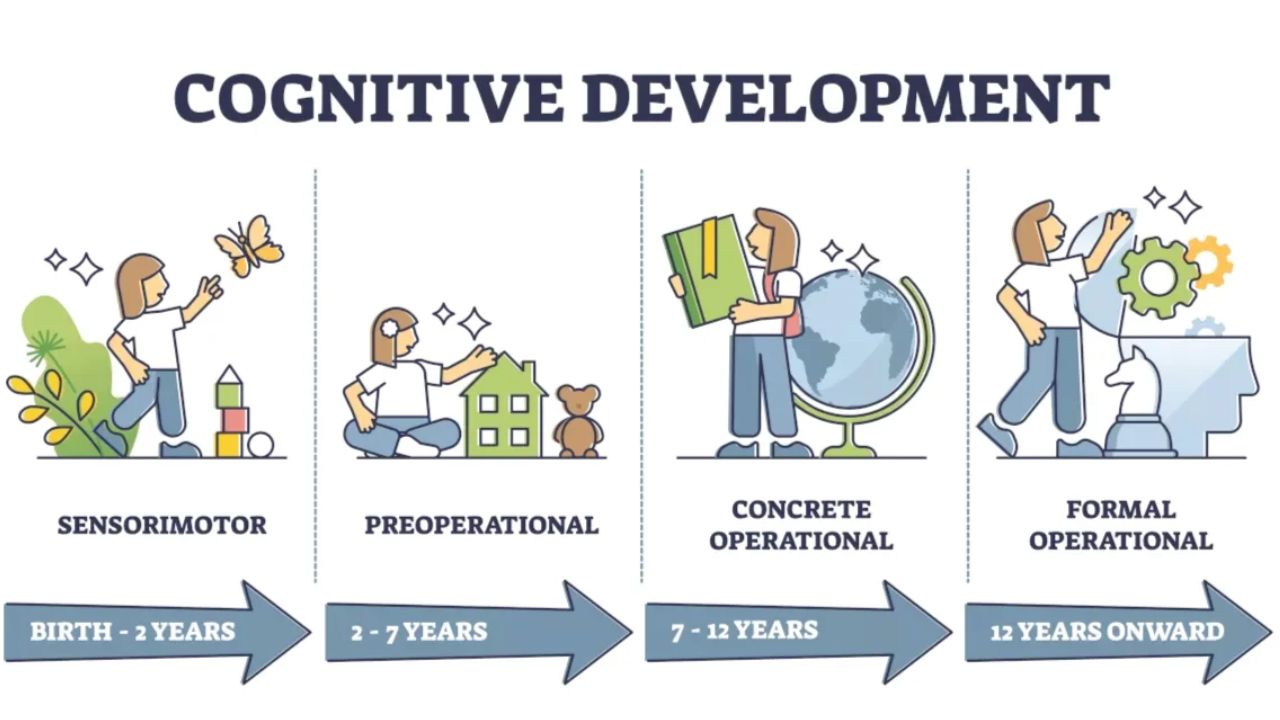
a. Sensorimotor Stage:
It is the first stage of the child’s cognitive development. This stage lasts approximately two years from the child’s birth. The baby learns about the world through sensory experiences and motor activities.
The sensory experiences are hearing and seeing. The motor activities are reaching, touching, and grasping. During this stage, the object permanence skill development takes place.
Piaget studied object permanence with blanket and ball study. He hid the ball under the blanket when the child was watching. He said that a child searching for the ball would be evidence of object permanence. He showed that object permanence indicates the cognitive functioning movement to the next stage.
b. Preoperational Stage:
A child’s language and abstract thinking skills start developing during this stage. This stage starts from two years and lasts till six or seven years.
The ideas and concepts that the child can think of are not physical. They do not focus on objects or people but on mental imagery.
The children start assuming that other people have emotions. However, they exhibit egocentrism by just focusing on themselves. The most significant characteristic in this stage is Centrism.
Centrism means that the child can concentrate on one problem at a time. During this stage, the children do not play with each other. They do a parallel play. They do think that the toys have feelings.
c. Concrete Operational stage:
This stage occurs during the phase of seven to eleven years of age. Now the child starts to think logically and develop problem-solving skills.
But they apply these skills to see concrete objects. Five concrete operations develop during this stage. They are:
- Conservation
- Classification
- Seriation
- Reversibility
- Decentering
Conservation:
The children understand that quantity remains the same despite different looks. For example, a cup of milk in a tall glass looks different from the same amount in a small glass. But the amount did not change.
Classification:
The children can classify objects based on color, shape, and size. Children can group objects by their features. For example, the dog comes under animals and is a group of pets.
Seriation:
This skill involves mentally arranging the object in an order based on shape, size, and color. Seriation demonstrates advancement in the child’s cognitive skills. Because they understand the characteristics to compare and contrast them. For example, the child can arrange the sticks of various sizes from small to large.
Reversibility:
Reversibility is the skill by which children understand that objects can be manipulated and reversed. It is the fundamental part of logical thinking. This process is suitable for developing more critical and logical mathematics-solving skills. For example, you can blow up a balloon and deflate it.
Decentering:
With decentering, the child can consider the multiple aspects of the problem. It is a significant cognitive achievement. It helps the children to focus on many things with a tendency known as Centration. For example, a child can understand that the volume of water is the same in tall, thin glass and small, wide glass.
d. Formal Operational Stage:
The final stage of cognitive development starts from the age of eleven or twelve onwards. During this stage, the problem-solving and logical thinking skills develop. The child can drive conclusions from the information they gain from the environment. For example, the children identify the dog breeds instead of dogs in the general category.
Piaget believed that development progress happens in all children at different rates.
Social Cognitive Theory:
Albert Bandura put forth the social cognitive theory in 1980. He conducted the “Bobo Doll experiment” to study children’s observational learning. It was earlier called Social learning theory.
It states that humans acquire beliefs, attitudes, and behaviors from environmental events. For example, a child views the world by observing the people and the interactions that happen.
It offers a bi-directional perspective to study human behavior. Though humans learn from their environment, internal consciousness also guides them. Humans are personal agency people and external influences prey.
The personal determinants are knowledge, skill, and attitude about behavior. Behavioral determinants are skills, self-efficacy, and practice. Environmental determinants are societal norms and external influence.
The four human capabilities this theory portrays are as follows:
- Symbolising capacity
- Self-regulatory capacity
- Self-reactive capacity
- Vicarious capacity
The Classic Bobo Doll Experiment:
He experimented to explain observational learning. He had two experimental groups and one controlled group of children.
The first group saw a person aggressively playing with the Bobo doll video. The second group saw a person kindly playing with the Bobo doll video. The control group does not watch any videos.
They are all sent to a room with a Bobo doll. The observation was that the first group aggressively played with the Bobo doll. The second group and control group did not play aggressively.
From this experiment, he proved that external factors influence children’s behavior.
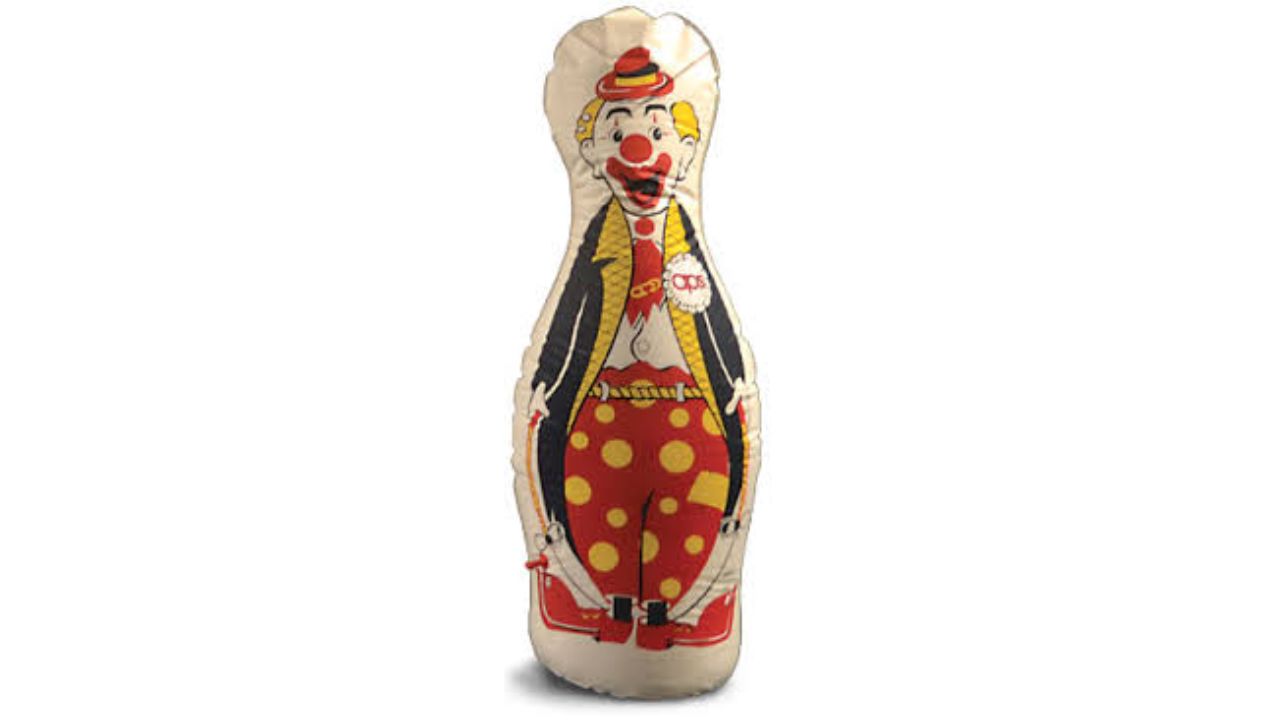
The motivational factors of this theory are as follows:
- Modeling:
People engage in certain behaviors when others get successful results by modeling them.
- Outcome Expectations:
People imitate other people’s behaviors to get the output results as expected. Reinforcements drive observational learning.
- Self-efficacy:
The people learn vicariously and proceed if they have the efficacy to do it. It is the belief that a person has over his abilities. For example, Prince knows that starting a business would boost his income. He does not proceed to fear of loss.
Theories by other researchers:
Researchers did further studies to improvise Piaget’s theory. There was a statement that the development was more continuous than he suggested. Leo Vygotsky made a statement that Piaget considered an individual child. He added that Piaget did not consider how culture and environment affect development.
Evolutionary development psychology portrays how genetics, ecology, and cultural context affect cognitive development.
Despite criticism, Piaget’s theory pioneered the child’s cognitive development. His theory acts as a reference for the current researchers. However, research is going on to find how children get cognitive skills in their social world.
Importance of Cognitive Development:
Children acquire, organize, and learn to use knowledge with cognitive development. It helps them to learn new things and participate in the society around them. It also allows the children to resolve challenges on their own.
Cognitive development allows the child to interact with the people in the outside world.
These skills help them to participate lifelong in society.
Cognitive milestones specify cognitive skills development in the child’s lifetime.
Cognitive Development Milestones:
These are the behaviors and skills demonstrated by particular age groups. They tell us how the child’s brain is developing using cognitive skills. An infant learning speaking skills is an example of a development milestone.
This assessment helps you analyze the child’s development. Researchers and professionals check for children’s cognitive skills development.
If they find delays, they provide support for them. Various assessment tools are available to check children’s cognitive development milestones.
There are milestones based on age from infancy to early adolescence. They mainly follow Piaget’s theory of cognitive skills development. The development milestones help the parents and researchers with a child growth analysis. However, the child must develop at its own pace.
The child may achieve the milestone earlier or later. The milestones act as a source of help, not anxiety. At the same time, you must involve yourself in the child’s development.
The child’s development also depends on the person in their close environment. You can improve your child’s skills by using various activities for their age group.
Conclusion
Cognitive development is a process that starts the day you’re born and it continues till the end of your life.
I hope this guide on cognitive development has helped you understand this complex subject easily, as I intended to.
If you loved reading this, don’t forget to share this with your friends, family, and colleagues.
Finally, for reading more such content on topics like mindset and self-help, you can always scroll through the website.

